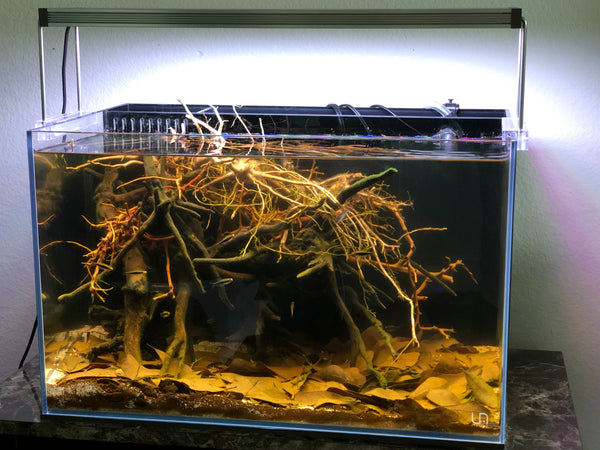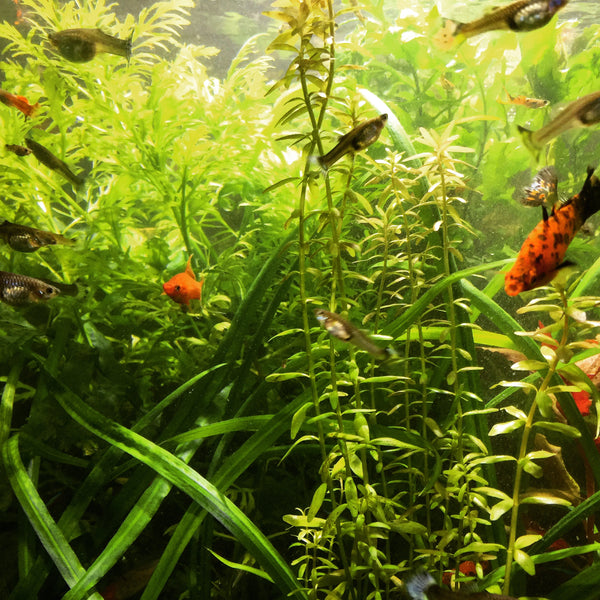- Continue Shopping
- Your Cart is Empty
No magic elixir...
As more and more hobbyists start incorporating botanical materials in all sorts of aquariums, we are once again exposed to a lot of different approaches, ideas, and "techniques."
There is a sort of "blending" of approaches and techniques- all of which serve to bring us joy and appreciation for the wonders of Nature. However, we often tend to "edit" Nature, polishing out or trying to "bypass" the processes, aesthetics, and functions that we find distasteful- in search of what we have generically called a "balanced" aquarium.
It's a noble, important goal. However, I think we need to understand that Nature seeks "balance" in Her own way- one that really doesn't take into account our schedules, goals, or aesthetic preferences.

And it's well known that an aquarium is a closed ecosystem that can easily "fall out of balance."
We often say it's "delicate"- but I don't think that it is. Rather, it's a robust system, which establishes itself in a way that utilizes "what's available" at any given time. And sometimes, it results in the pendulum shifting from one life form to another. The "balance" may be delicate; in that various life forms can "take over" at any given time- and rapidly, too. However, if you've ever battled something like an algae bloom- you'd never call the life forms themselves "delicate", right?
They're tenacious. You have to respect that. Any life form that takes advantage of optimum conditions to thrive is at least worthy of some appreciation- even if it looks like- well- shit, right?
Sure. excessive algae growth is a sign of imbalance of something- light, nutrients, often exacerbated by deficiencies in husbandry, or a combination of these factors. This is "Aquarium Keeping 101", of course, but when you're in the middle of these kinds of struggles, it's easy to overlook seemingly "basic" stuff.

It is not always easy or clear to understand why a tank is "out of balance." Sometimes, it just takes time to figure it out. I think the important thing is to think of an aquarium- especially our botanical-style aquariums- as a small, closed ecosystem or microcosm, with internal and external influences-any one of which may be extremely impactful when they converge.
Understanding that the various possible impacts that our techniques and executions may have on our aquariums is just the start. On the most superficial level, adding a lot of botanical material into a tank is a recipe for: a) a lot of bioload for resident organisms to process, b) a substrate for biofilm and/or algal growth, and c) biodiversity- a proliferation of a variety of organisms.

And of course, "bioload" can be taken advantage of by a particularly adaptable life form which could proliferate more quickly than others...throwing your little ecosystem "out of balance."
This is part of the reason why the so-called "Walstad Method" for planted aquariums, which I love dearly, proffers incorporating fast-growing plants from the start..They will compete with algae for the same nutrients, and typically, they'll out-pace the algae as they grow.
It's about starting out your aquarium to empower various life forms to help seek a balance.
In our "Urban Igapo" approach, we advocate what amounts to a "dirted bottom" aquarium, sans aquatic plants (at least, initially) and a "sand cap" over the soil. Rather, we plant terrestrial plants and/or grasses (ideally, submersion-tolerant ones) during the "dry" phase. And of course, when we add water, the abundance of nutrients in the substrate creates a significant "bioload" in the now aquatic environment.
"Stuff" is going to happen.

Perhaps- do we dare say, the UI is the metaphorical "ugly stepchild" of the "Walstad Method?" Maybe, but I suppose that could be viewed as a bit presumptuous.
Ceding a lot of the control to Nature is hard for some to quantify as a "technique" or "method", so I get it. At various phases in the process, our "best practice" might be to simply observe...

And with plant growth slowing down, or even going completely dormant while submerged, the utilization of nutrients via their growth diminishes, and aquatic life forms (biofilms, algae, aquatic plants, and various bacteria, microorganisms, and microcrustaceans) take over. There is obviously an initial "lag time" when this transitional phase occurs- a time when there is the greatest opportunity for one life form or another (algae, bacterial biofilms, etc.) to become the dominant "player" in the microcosm.
It's exactly what happens in Nature during this period, right?

In our aquarium practice, it's the time when you think about the impact of technique-such as water exchanges, addition of aquatic plants, adding fishes, reducing light intensity and photoperiod, etc. and (again) observation to keep things in balance- at least as much as possible. You'll question yourself...and wonder if you should intervene- and how..

Someone in the system- one life form or another-will exploit the available resources, to the detriment of others, and the key here is observation, followed by intervention as needed/desired. "Intervention" being manipulation of environmental parameters or impacts in order to "rebalance" the ecosystem- if you can,or if you feel you must.
Like in any aquarium, there is no "magic elixir"- no single solution to a situation like this.
It's about a number of measured moves, any of which could have significant impact- even "take over" the system- if allowed to do so. This is part of the reason why we don't currently recommend playing with the UI on a large-tank scale just yet. (that, and the fact that we're not going to be geared up to produce thousands of pounds of the various substrates just yet! 😆)

Until you make those mental shifts to accept all of this stuff in one of these small tanks, the idea of replicating this in 40-50, or 100 gallons is something that you may want to hold off on for just a bit.
Or not.
I mean, if you understand and accept the processes, functions, and aesthetics of this stuff, maybe you would want to "go big" on your first attempt. However, I think you need to try it on a "nano scale" first, to really "acclimate" to the idea.

The idea of accepting Nature as it is makes you extremely humble, because there is a realization at some point that you're more of an "interested observer" than an "active participant." It's a dance. One which we may only have so much control- or even understanding of! That's part of the charm, IMHO.
These habitats are a remarkable "mix" of terrestrial and aquatic elements, processes, and cycles. There is a lot going on. It's not just, "Okay, the water is here- now it's a stream!"
Nope. A lot of stuff to consider.

In fact, one of the arguments one could make about these "Urban Igapo" systems is that you may not want to aggressively intervene during the transition, because there is so much going on! Rather, you may simply want to observe and study the processes and results which occur during this phase. Personally, I've noticed that the "wet season" changes in my UI tanks generally happen slowly, but you will definitely notice them as they occur.
After you've run through two or three complete "seasonal transition cycles" in your "Urban Igapo", you'll either hate the shit out of the idea- or you'll fall completely in love with it, and want to do more and more work in this alluring little sub-sector of the botanical-style aquarium world.

The opportunity to learn more about the unique nuances which occur during the transition from a terrestrial to an aquatic habitat is irresistible to me. Of course, I'm willing to accept all of the stuff with a very open mind. Typically, it results in a fascinating, utterly beautiful, and surprisingly realistic representation of what happens in Nature.

It's also entirely possible to have your "Urban Igapo" turn into an "Urban Algae Farm" if things get out of balance. Yet, it can "recover" from this. Again, even the fact that a system is "out of balance" doesn't mean that it's a failure. After all, the algae is thriving, right? That's a success. Life forms have adapted. A cause to celebrate.
It happens in Nature, too!

I know, seems weird. What we've long feared- what we've always felt looked like "failure"- is actually something to cherish. A huge, HUGE "mental shift" that literally goes against every single thing you've been taught in the hobby.
Scared yet?
I can see why you would be.
We're essentially asking you to do the equivalent of turning a potted plant into a fish pond. And that's sort of- well, sort of crazy, right? Well, maybe not. I mean, this transition has been happening in the igapo- the flooded forests- of South America for eons. Nature has processes, organisms and parameters which allow this annual transition to occur. Life forms have adapted to this cycle.

Now, sure, the forests of South America are open ecological systems, and your 2-gallon "Urban Igapo" in suburban Cincinnati isn't...On the other hand, the same processes and laws which govern the functions of the forest impact the function in your little experimental glass box.
Once again, the idea of a "mental shift" to accept and understand the processes and the way they look and impact our closed systems is a huge part of the equation. Think about this: Yeah, the tank may look like a cloudy, brown, glass full of shit at some phases of the terrestrial-aquatic transition. However, there are reasons why, right? Nature is trying to establish a functioning little ecosystem, and not all of this fits our definition of "attractive."
But it's "natural."
And what's wrong with it? The looks? I mean, are your fishes dying? No? Than what's the real "problem" here?
Yeah, I know, it's a weird way of thinking of this.

If you make this kind of "mental shift", you'd even be ablel to tolerate, accept, and even appreciate the appearance of biofilms, "beard algae", fungal growth, and any number of things that you'd likely see during this environmental transition. It's simply Nature working through her transitional process.
Yet, accepting all of this stuff-aesthetic and otherwise- is contradictory to what we've been taught over generations to be "acceptable" in an aquarium. However, if you really want to own a real "Nature Aquarium" (sic), then I think that you need to make this big "mental shift."
This is what Nature looks like.

And there is no single thing that you can do, change, or add to magically transform your "Urban Igapo" into a shiny-clean, perfectly-balanced closed ecosystem. No "magic elixir" or single practice to get you perfectly predictable results every time.
Rather, its a series of changes, practices, processes, and the passage of time, which we as hobbyists need to study, understand, and accept. The whole idea of the UI is to foster a closed ecosystem- to replicate, on a small scale- what happens in Nature. It starts by accepting what happens in Nature, and letting it play out in our aquariums.

Nature finds a way. Nature knows how to do this.
It's up to us to decide wether to understand and accept- or to resist and circumvent the offerings of Nature.
Which way will you go?
Regardless...
Stay determined. Stay curious. Stay observant. Stay patient. Stay resourceful. Stay open-minded...
And Stay Wet
Scott Fellman
Tannin Aquatics







Scott Fellman
Author